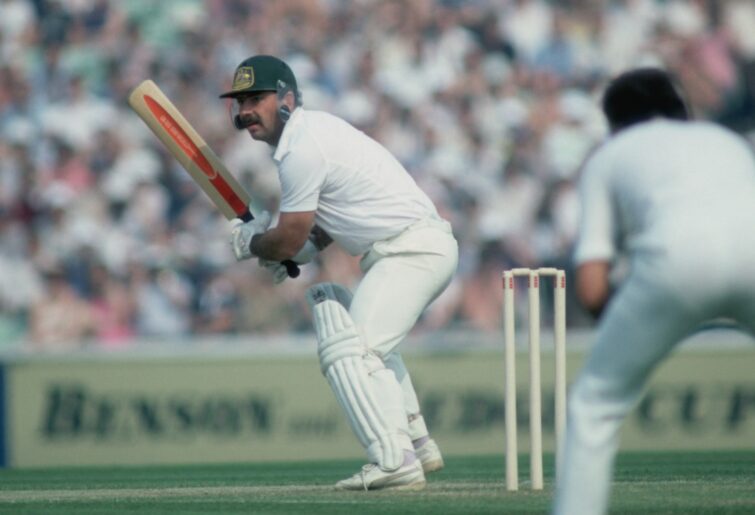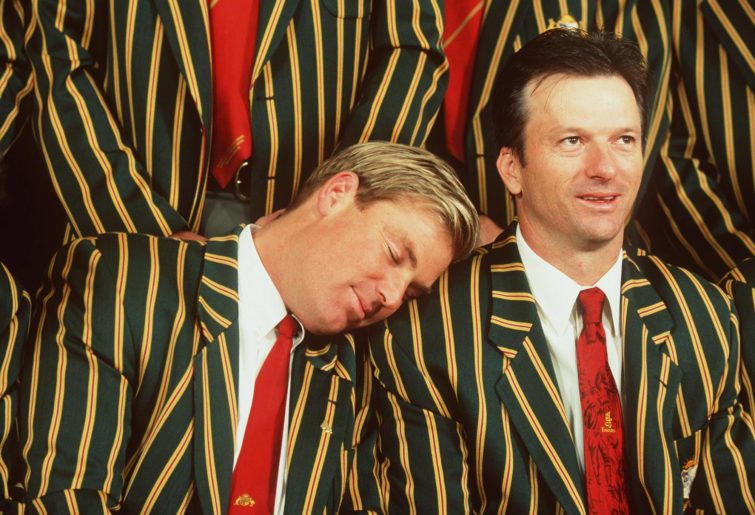Last year was a memorable one on many levels, but sadly it also marked the end for some of Australia’s greatest cricketers. Let’s take some time to remember the Australian Test players who left us for good in 2022.
Phil Carlson
Carlson emerged from Brisbane’s Northern Suburbs club in 1969 to gain selection as an 18-year-old batsman for Queensland, but soon developed into a very good all-rounder, making solid contributions with both bat and ball, and proving himself to be a very good slip fielder.
The Australian Test selectors, looking for fresh talent to replace the host of players lost to World Series Cricket, eventually came calling in 1978, and Carlson was named 12th man for both the first and second Tests of the series against the touring English team, before finally getting his opportunity to show his wares in the fifth Test in Adelaide in January 1979.
He bowled first change, without taking a wicket and was dismissed for a duck when it was his turn to bat. He fared a little better in the second innings of the game though, dismissing both Mike Brearley and Graham Gooch, and scored a steady 21 with the bat. Unfortunately, the sixth Test of the series was to be Carlson’s last, as England won the series 5-1, but he continued to represent Queensland for the next couple of years.
Phil Carlson only played two Tests and accordingly had a very modest Test record, but he scored 3096 runs in 91 first class games at an average of 28.34 and took 124 wickets at 24.96.
Phil Carlson passed away in July 2022.
Rod Marsh
Put simply, Rod Marsh changed the role of the wicket-keeper forever. Before his emergence in the 1970s, the wicket-keeper was largely seen as a specialist fielding position, but Rod Marsh turned the position into that of an all-rounder, where the keeper also became an important part of the batting order.

Rod Marsh (Photo by Adrian Murrell/Getty Images)
It comes as no surprise that Marsh made his first class debut for Western Australia as a specialist batsman in 1968, scoring both a duck and a quickfire century in that match against the touring West Indies, as it seemed in those early years that his batting skills were more finely tuned than his skills behind the stumps.
Marsh’s batting prowess saw him controversially selected for his Test debut against the touring English team in 1970, replacing popular NSW Test incumbent Brian Taber, and queue jumping the likes of Ray Jordan and John Maclean, and although to some it looked like he was still learning the wicket-keeping ropes on the job, he soon established himself as the then best Australian wicket-keeper of all time, a vital cog in the Australian cricket machine, and the centre of the team’s spirit and culture.
Marsh will be remembered for many things, both factual and some the stuff of legend, but none more so than his career-long partnership with the great fast bowler Dennis Lillee. They both hailed from Perth, made their first class debuts for WA within a year of each other, made their Test debuts in the same series against England, played WSC together with distinction, played their last Test together in 1984, and each finished with 355 Test dismissals, 95 of which were “caught Marsh, bowled Lillee”. Remarkable!
Rod Marsh was also the inspiration for thousands of young cricketers, myself included, to become wicket-keepers who thought that they could bat a bit.
Rod Marsh played 96 Tests, had 355 dismissals, and scored 3633 runs at an average of 26.51, including three centuries and 16 half-centuries.
Rod Marsh passed away in March 2022.
John Rutherford
John Rutherford may have only played one Test match, but he’ll forever hold the honour of being the first Western Australian-based player to play in a Test for Australia. Originally from Bruce Rock in WA’s eastern wheat belt, the dour opening bat and part-time leggie finished his secondary and tertiary education in Perth, played club cricket there, and then debuted for his state in the 1952-53 season.
Gaining national selection from WA back in those days was next to impossible, but Rutherford persisted and did well enough in his limited Sheffield Shield opportunities against the eastern states to earn a place in the Australian side to tour England, India and Pakistan in 1956.
His first, and only, Test opportunity came following the English leg of the tour, when he was called into the team to open the batting alongside Jim Burke in the second Test against India in Bombay. He scored 30 in Australia’s only innings and took a wicket, but didn’t play for Australia again.
He continued his successful first class career until 1960, when he suffered a stroke on the field while captaining WA against the touring West Indian team, which forced his retirement.
John Rutherford scored 3367 runs in 67 first class games at an average of 31.76, including six centuries and 15 half-centuries, and took 29 wickets at 45.27.
John Rutherford passed away in April 2022.
Andrew Symonds
If there was ever any doubt that a young Andrew Symonds was going to be a star cricketer, they were quickly dispelled when he scored a double century in his Queensland Premier grade cricket debut at the age of 15. His batting prowess is still mentioned in awe at his junior club, the Gold Coast Dolphins, and it wasn’t long until the rest of the world also became familiar with his unique array of talents.
He was the prototype of the ultimate all-rounder. A destructive batsman who specialised in sending the ball either to or over the boundary with regularity, able to bowl both medium pace and off-spin with good effect, one of the best all-round fieldiers of his era, and a deadly run-out specialist.

Ricky Ponting and Andrew Symonds (Photo by Getty Images)
Symonds made his Sheffield Shield debut for Queensland in 1994 and was a regular member of Australia’s ODI squad from 1998, but he had to wait another six years for his chance in the Test team. His aggressive batting style often let him down, however, and saw him in and out of both the Australian Test and ODI sides during his career, but when he put his mind to it, there was none better than Symonds, and none more entertaining to watch.
Anyone who saw him score 143 off 125 balls against Pakistan in the 2003 World Cup when Australia were in trouble, or his 162 not out in the second Test against India in Sydney in 2008, will attest to that.
Symonds was a larger than life character, his own man, and someone who never felt the need to conform. It’s unlikely we’ll see another like him.
Although ultimately a more prolific ODI player for Australia than a Test player, it’s his Test record that best reflects his true abilities. Andrew Symonds played 26 Tests, scored 1462 runs at 40.61, with a strike rate of 64.80. He hit two centuries and 10 half-centuries, took 24 wickets at 37.33, and took 22 catches.
Andrew Symonds passed away in May 2022.
Alan Thomson
How Alan Thomson was able to bowl fast with his front-on windmill action without doing himself a mischief remains a mystery to me, and I still recall one of our club’s fast bowlers trying to emulate him in the nets once with almost disastrous consequences. Batting against Thomson would also have been challenging until you became accustomed to his action.
Thomson was selected for Victoria from the Fitzroy Cricket Club in 1969 and really hit the ground running, taking six NSW wickets in the first innings and then backed up in his second match to take 11 wickets for the match against the touring West Indian team.
His good Shield form continued, and by the time he was called into the Australian test team for the first Test against the touring English side in November 1970, he’d taken 120 first class wickets at just 20.01.
He debuted alongside both Rod Marsh and Terry Jenner in the drawn match, but struggled with the step up in class, and finished with match figures of 1/156, but at least he gave the visitors some hurry up with his very effective bouncer.
He played in the second Test, then wasn’t selected for either the third or fourth Tests, but was back again for the fifth and sixth of the marathon series. He produced his best Test results in the sixth Test, taking five wickets for the match, but lost his place in the side to Queenslander Tony Dell for the seventh and final Test of the series. He didn’t play Test cricket again but continued to represent Victoria through to the 1974-75 season.
Alan Thomson was a bowler who was “once seen, never forgotten”, who took 184 wickets in his 44-game first class career at the respectable average of 26.72.
Allan Thomson passed away in October 2022.
Shane Warne
So much has been said and written about Shane Warne since his untimely death early last year that it doesn’t need repeating here. Put simply, Warne was the greatest spin bowler in the history of the game, an Australian sporting icon both in life and death, and a sportsman who rose above his humble beginnings to rub shoulders with the rich and famous and live the life that we would all have loved to experience, even if just for a day or two.

(Credit: Robert Cianflone/ALLSPORT)
While most of us watching from the SCG’s M. A. Noble stand in January 1992 when he made his Test debut against the touring Indian team could sense there was something to like about the swagger and body language of the chubby 22-year-old tweaker rom Victoria, few could ever have imagined where his career would take him, and fewer still would have predicted he’d take even 100 Test wickets in his career, as rampant Indian batsmen Ravi Shastri and Sachin Tendulkar helped Warne to debut bowling figures of 1/150.
His career was full of too many highlights to mention, but no one, least of all Mike Gatting, will ever forget the first ball Shane Warne bowled in Ashes cricket in 1993, and who could forget the 8/71 he took to bowl Australia to victory in the first Test against England at the Gabba in November 1994? It was as if something was always about to happen when Warnie had the ball in his hand.
Sometimes it seemed that following Shane Warne’s life and career was like watching either a soap opera or a reality TV program, and he was often a polarising figure, and one of the tallest of poppies to be cut down. But in the end we were fortunate to have seen him play, and perhaps it was fitting that he was taken from us so early, as they say that only the good die young.
Shane Warne played 145 Tests, took 708 wickets at 25.41, held 125 catches, and scored 3154 runs at 17.32, including 12 half-centuries.
Shane Warne passed away in March 2022.
>Cricket News

%20(3).jpeg)



0 Comments